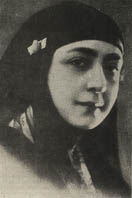
Huda Shaarawi (1879-1947), a feminist nationalist activist, is considered to be a central figure in early twentieth century Egyptian feminism. Born into a very wealthy family, Shaarawi spent her early years in the harem, an experience described in her memoirs, Harem Years.
Philanthropic Work
Shaarawi was involved in philanthropic projects throughout her life. In 1908, she created the first philanthropic society run by Egyptian women, offering social services for poor women and children. She argued that women-run social service projects were important for two reasons. First, by engaging in such projects, women would widen their horizons, acquire practical knowledge and direct their focus outward. Second, such projects would challenge the view that all women are creatures of pleasure and beings in need of protection. To Shaarawi, problems of the poor were to be resolved through charitable activities of the rich, particularly through donations to education programs. Holding a somewhat romanticized view of poor women’s lives, she viewed them as passive recipients of social services, not to be consulted about priorities or goals. The rich, in turn, were the “guardians and protectors of the nation.” (See Women, Islam, Hijab and Gender and Nation)
Egyptian Feminist Union
Shaarawi was a feminist activist throughout her life. In 1914, she founded the Intellectual Association of Egyptian Women. In 1923, she founded the Egyptian Feminist Union (EFU), in which she was to remain active throughout her life. The EFU consisted of upper and middle class Egyptian women, and at its height had about 250 members. The EFU focused on various issues, particularly women’s suffrage, increased education for women, and changes in the Personal Status laws. While the EFU accomplished few of its goals, it is widely credited with setting the stage for later feminist victories.
Involvement in Nationalist Struggle
Shaarawi was very involved in the Egyptian nationalist struggle, and was a central player in organizing a march of upper and middle class women against the British in 1919. In 1920, she became the president of the Wafdist Women’s Central Committee. Much to the dismay of Shaarawi and other women activists, following independence, the new government denied women suffrage. Shortly afterwards, when the government barred women from the opening of the Egyptian Parliament, Shaarawi led a delegation of women to picket the opening. Revealing the interrelatedness of their feminist and nationalist beliefs, the protesters issued a list of 32 feminist, social, and nationalist demands. Eventually, in 1924, Shaarawi split from the Wafdist Central Committee, and began to devote her time to the EFU.
Ties with International Women’s Movements
Part of Shaarawi’s motivation for founding the EFU was her desire to send a delegation of Egyptian women to the 9th Congress of the International Women’s Suffrage Alliance in Rome, in May 1923. In a speech at this conference, Shaarawi advanced her conception of Egyptian feminism. She argued, first, that women in ancient Egypt had equal status to men, and only under foreign domination had women lost those rights. Second, she argued that Islam also granted women equal rights to men, but that the Koran had been misinterpreted by those in power. Shaarawi and the EFU maintained their ties with the International Women’s Suffrage Alliance for several years. However, in the 1930s, increasingly influenced by the nationalist movement in Palestine, Shaarawi and her colleagues began to define nationalism in pan-Arab, rather than Egyptian, terms. In addition, they became increasingly suspicious of Western feminists, and began to cast their feminist struggle in pan-Arab terms as well. Eventually, they broke their ties to the Suffrage Alliance. In 1945, Shaarawi and the EFU played a major role in founding the All Arab Feminist Union.
Shaarawi and the Veil
Upon her return from the Rome conference in 1923, Shaarawi performed an act that has come to stand as a central symbol of her life: she removed her veil in public at a Cairo train station. While clearly a bold act, its significance may be somewhat exaggerated, since Shaarawi herself argued for a gradualist approach to veil removal. In fact, removal of the veil was never on the EFU’s agenda. In addition, the veil was only an issue for the wealthiest women in Egyptian society, since only they wore it. Thus, ironically, what Shaarawi is best known for — removing her veil — is an issue to which she herself chose to devote little time.
Sources
- Badran, Margot. Feminists, Islam and Nation: Gender and the Making of Modern Egypt. Princeton, NJ: Princeton U. Press, 1995.
- Baron, Beth Ann. “Unveiling in Early Twentieth Century Egypt: Practical and Symbolic Considerations.” Middle Eastern Studies. 24(3): 370-86.
- Hatem, Mervat. “Egyptian Upper- and Middle-Class Women’s Early Nationalist Discourses on National Liberation and Peace in Palestine (1922-1944).” Women and Politics. 9(3): 49-69.
- Kader, Soha Abdel. Egyptian Women in a Changing Society, 1899-1987. Boulder, CO: Lynne Rienner Publisher, 1987.
- Shaarawi, Huda. Harem Years: The Memoirs of an Egyptian Feminist. Translated and introduced by Margot Badran. New York: The Feminist Press, 1987.
Author: Melissa Spatz, Fall 1996
Last edited: May 2017

2 Comments
Pingback: Why We Rarely Hear the Term “Muslim Feminist” - The Chicago Monitor
Yes she is a hardworking woman and she try during her life time and I will like to know how her life ended women like her a very rare and I want more women to be like her because she try to see that every women is equal with the opposite genda we need more women like her if I was alive by that time I would have join her in this calling I know she will be inspired by many women oh God we missed her may her soul rest in peace